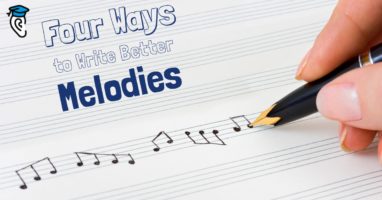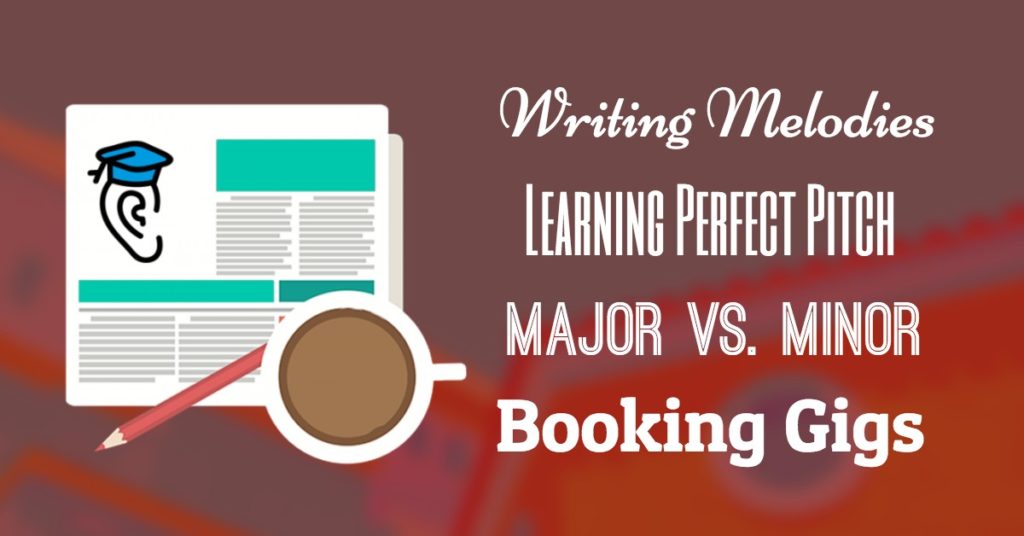What does it take to make it in music? You might think you need perfect pitch, or a talent for writing catchy melodies. A keen ear for the subtleties of major and minor, or advanced transcription ear training skills. Perhaps you reckon it all boils down to just writing thousands of songs and booking hundreds of gigs…
Or maybe the key to success lies in a new instrument you haven’t tried yet? (If that’s the case, check out the guest post I wrote this week over at TakeLessons.com: The 5 Easiest Instruments Perfect for Adult Learners!)
Whatever your belief might be, we can probably agree that each of these things can play its part! In this week’s new resources we have tips and guides to help you develop your musicality in a variety of ways and help increase your odds of musical success.
Let’s get started with a controversial one… Perfect pitch!
Perfect Pitch Possibilities
Contrary to what you might have heard, perfect pitch can be learned if you work at it. That said, we think you might be better off learning relative pitch instead… The Musical U team weigh in on this ongoing debate with Perfect Pitch: Can It Be Learned?
If you’re a bit confused about “being pitch perfect”, “having perfect pitch” or “perfect vs. relative pitch” then Michael A. Levine for Soundtracks and Trailer Music has written a great piece on what exactly perfect pitch is.
Feeling discouraged because you don’t have perfect pitch and learning it sounds like hard work? Don’t worry! Violin teacher Eloise Hellyer explains that perfect pitch can sometimes be more of a hindrance than a help.
We just found out that humans aren’t the only ones who can spot perfect pitch… It turns out that monkeys can, too!
Getting Booked
Your band is ready. You’ve planned and prepped and you’re confident in your killer show. Now it’s time for your awesomeness to go live! In other words, you need to, y’know, book a gig. Get tips on booking gigs for your band in Performing Live, Part 3: Booking the Show
Not sure if you’re ready to book gigs yet? Brian Brushwood talks you through what you need to do to get started:
Then AudioTheme has a set of steps you can follow to book gigs for your band and Symphonic Distribution suggests three unconventional places you can book gigs.
Learn to Write Better Melodies
 Are you writing a new song? Want to make sure it becomes an all-time classic? Writing a catchy melody is probably the most important thing you could do to ensure your song’s success. So what exactly makes a good melody and how do you improve your melody writing skills? Find out in Four Ways to Write Better Melodies.
Are you writing a new song? Want to make sure it becomes an all-time classic? Writing a catchy melody is probably the most important thing you could do to ensure your song’s success. So what exactly makes a good melody and how do you improve your melody writing skills? Find out in Four Ways to Write Better Melodies.
Here are some great melody writing techniques from Uberchord, who say that “a song’s melody is its soul, what makes a piece unique”, and Jason Blume for BMI is ready to save you from the melody pitfalls most often encountered when writing songs.
Do you have a tendency towards perfectionism in your song writing? Maybe you could take a leaf out of Heitor Villa-Lobos’ book: “He’d scribble down ideas as they came to him, and would rarely return to polish the finished article. He just wanted to get the music out there.” (Classical: From Bach to Brazil – the sweet music of Heitor Villa-Lobos)
Speaking of whom…
Listen to 5 tracks – by the composer of over a thousand!
 Heitor Villa-Lobos was a 20th Century Brazilian composer who composed over 1,000 pieces in his lifetime. Performers and listeners are attracted to his music for its fresh and dance-like energy.
Heitor Villa-Lobos was a 20th Century Brazilian composer who composed over 1,000 pieces in his lifetime. Performers and listeners are attracted to his music for its fresh and dance-like energy.
In Open Your Ears to Villa-Lobos you’ll be guided through five pieces from 1920-1951, including some of the composer’s most well known and beloved works. All of them boast the rhythmic energy and variety, romantic melodies, focused forms, and range of bright and dark timbres which are Villa-Lobos’ signature.
Learn more about the life of Heitor Villa-Lobos in this article from ARTax.
Two Shortcuts for Identifying Major vs. Minor Keys
Before you can play a song by ear or improvise over it, you’re going to want to know its key. That’s because a song’s key reveals which notes fit in the song. Learn to distinguish major keys from minor quickly using the two key-finding shortcuts in this recap article.
Sometimes you’re starting from sheet music rather than the sounds, and want to identify the key from the written score. LearnHowtoReadSheetMusic.com explains the secret to learning how to read key signatures in this brief video tutorial and key-notes.com have a handy key signature chart for you.
Which Part to Transcribe First?
 In the first part of Transcribe Music Like a Pro we covered the fundamentals of transcribing. So once you are ready to start, where exactly should you begin? Music can be complex and that can make the task of transcribing it seem overwhelming!
In the first part of Transcribe Music Like a Pro we covered the fundamentals of transcribing. So once you are ready to start, where exactly should you begin? Music can be complex and that can make the task of transcribing it seem overwhelming!
It’s normally best to transcribe the drum part before anything else. Find out why and how in
How to Transcribe like a Music Pro, Part 2: Drums.
Drummer Café recommends this step-by-step process for transcribing drum parts, which works for solos, grooves or entire drum tracks as part of a full-song transcription and drummer Joe Crabtree shares his own method in this video tutorial.
Whatever it may take to make it in music, I hope these new resources help you to improve your skills and increase the odds of you reaching what “success” means to you. Just remember to have fun and enjoy the music along the way!










